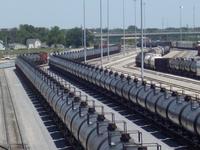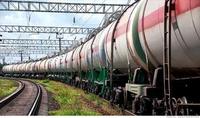-
U.S. RAILHow the U.S. Rail System Works
A spate of train derailments, most notably in East Palestine, Ohio, has reinvigorated the debate over the nation’s railroad infrastructure. Here’s how U.S. rail could be brought up to speed.
-
-
Transportation SecurityU.S. Unveils New Cybersecurity Requirements for Rail, Air
DHS has unveiled new measures to make sure the U.S. air and surface transportation sectors will not be crippled by ransomware or cyberattacks. The new measures will apply to “higher risk” rail companies, “critical” airport operators, and air passenger and air cargo companies.
-
-
Rail safetyConcerns about safety of rail transport of energy liquids, gases
The U.S. increased production of crude oil, natural gas, and corn-based ethanol created unforeseen demands and safety challenges on their long-distance transportation via pipelines, tank barges, and railroad tank cars. A debate is underway about whether the domestic energy revolution was placing stress on the transportation system that would sacrifice safety.
-
-
Transportation securityTerrorists shift focus of attacks from air transportation to rail systems
Terrorists have shifted their focus in recent years away from attacking airlines to attacking subway and rail systems, according to an analysis of terrorist attacks over a 30-year period from 1982 to 2011. The author of the new study notes that in a previous analysis, for the period 1968 to 10 September 2001, he concluded that air travel within the United States entailed a greater risk of a terrorist attack than “virtually any other activity.” Statistically significant evidence, however, points to a growing focus of terrorist attacks against ground mass transit.
-
-
Infrastructure protectionScanning technology detects early signs of potholes
Researchers are developing smart scanning technology using existing cameras to detect the early signs of potholes and determine their severity. a computer vision algorithm, combined with 2D and 3D scanners on a pavement monitoring vehicle, can examine the road with accuracy at traffic speed during day or night. The system works by detecting different textures of the road to identify raveling and distinguishes it from shadows and blemishes such as tire marks, oil spills, and recent pothole repairs.
-
-
Rail securityRailway stations should adopt some of the security strategies deployed by airports: Experts
A 2013 study by the U.K. Home Officerecorded crime rates across every postcode in England, Wales, and Northern Ireland, and found that four of the top ten U.K. crime hot spots are major railway stations. Railway stations experience large volume of crime due to their highly congested environments, which gives pickpockets and thieves opportunities to find a target. Large stations are also introducing more retail outlets, which increases the likelihood of more shoplifting offenses. Experts note that airports have many of those same characteristics, but they fare far better in crime rates. These experts argue that rail stations should adopt some of the strategies deployed by airports around the world.
-
-
HazmatSimulations help make transport of explosives safer
In 2005, a semi-truck hauling 35,000 pounds of explosives through the Spanish Fork Canyon in Utah crashed and caught fire, causing a dramatic explosion that left a 30- by-70-foot crater in the highway. The cause of the massive blast on the Utah highway, brought on by a process called deflagration-to-detonation transition (DDT), posed something of a mystery. The semi-truck was transporting 8,400 cylinders of explosives intended for blasting operations in the mining industry. Despite the cargo’s volatile nature, it was not supposed to detonate violently as it did. Such accidents are extremely rare but can obviously have devastating results. So understanding better exactly how such explosions occur can be an important step to learning how better to prevent them.
-
-
Rail securityConcerns grow about attacks on rail systems by domestic terrorists
Between September 2001 and December 2011, at least838 attacks on passenger rail systems have killed more than 1,370 people. As DHS officials focus on assuring the American public that security agencies remain on high alert, last week’s incidents on two of the nation’s major metropolitan rail systems raised more concerns about public safety and preparedness.
-
-
HazmatFeds, rail operators, Washington State embroiled in crude oil shipment disclosure dispute

Last month the U.S. Department of Transportation(DOT) ordered rail carriers with trains carrying crude oil to notify state officials in the states through which the trains pass about the volume, schedule, and routes of these trains. The amount of crude oil transported by trains has grown dramatically – from 6,000 carloads in 2005 to more than 400,000 carloads in 2013. The increase in the volume of crude oil shipping has been accompanied by a sharp rise in the number of accidents and derailments. DOT’s order was meant to allow states’ first responders to be prepared, but the railways treat shipping information as “security sensitive” and refuse to share it with states’ officials unless the information is distributed to emergency response groups for planning purposes only. Washington State says that state laws require that such information be made public.
-
-
Rail securityMore crude oil shipments by rail mean more accidents, but security measures lag

American rail companies have long operated under federal laws, making it difficult for local officials to gather information on cargo and how rail companies select their routes. An increase in the number of trains transporting crude oil, accompanied by a series of derailments and explosions, has highlighted the dangers of transporting hazardous substances by rail.In February, the Department of Transportation announced that railroads had voluntarily agreed to apply the same routing rules to oil trains that they currently apply to other hazardous materials. Critics say more needs to be done.
-
-
Port securityRadiation detection equipment installed in four Mexican ports
The Megaports Initiative is a U.S. Department of Energy program intended to enhance the ability of ports around the world to detect and interdict illicit shipments of special nuclear and other radioactive materials; Under the initiative, radiation detection gear and protocols were implemented in the Mexican ports of Manzanillo, Altamira, Lazaro Cardenas, and Veracruz, through which 92 percent of Mexico’s containerized cargo pass
-
-
TransportationNew side mirror eliminates blind spot for drivers

A side mirror that eliminates the dangerous “blind spot” for drivers has now received a U.S. patent; the subtly curved mirror dramatically increases the field of view with minimal distortion
-
-
Ground transportationNew insights into terrorist threats to ground transportation
A new analysis of terrorist attacks, and attempted attacks, on ground transportation shows that from the late 1980s to the mid-1990s, terrorist groups used chemicals to attack surface transportation; from the mid-1990s on, multiple bombs became the new prototype for terrorist attacks
-
-
Transportation securityNY-NJ Port Authority centralizes security operations
The Port of Authority of New York and new Jersey has created a stand-alone Security Department and is now searching for a Chief Security Officer to oversee all security and safety functions, resources, and personnel
-
-
Sector Report for Thursday, 26 May 2011: Transportation Security
This report contains the following stories.
-
- All
- Regional
- Water
- Biometrics
- Borders/Immig
- Business
- Cybersecurity
- Detection
- Disasters
- Government
- Infrastructure
- International
- Public health
- Public Safety
- Communication interoperabillity
- Emergency services
- Emergency medical services
- Fire
- First response
- IEDs
- Law Enforcement
- Law Enforcement Technology
- Military technology
- Nonlethal weapons
- Nuclear weapons
- Personal protection equipment
- Police
- Notification /alert systems
- Situational awareness
- Weapons systems
- Sci-Tech
- Sector Reports
- Surveillance
- Transportation
Advertising & Marketing: advertise@newswirepubs.com
Editorial: editor@newswirepubs.com
General: info@newswirepubs.com
2010-2011 © News Wire Publications, LLC News Wire Publications, LLC
220 Old Country Road | Suite 200 | Mineola | New York | 11501
Permissions and Policies
Editorial: editor@newswirepubs.com
General: info@newswirepubs.com
2010-2011 © News Wire Publications, LLC News Wire Publications, LLC
220 Old Country Road | Suite 200 | Mineola | New York | 11501
Permissions and Policies
